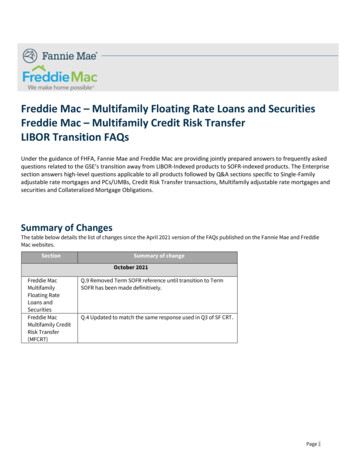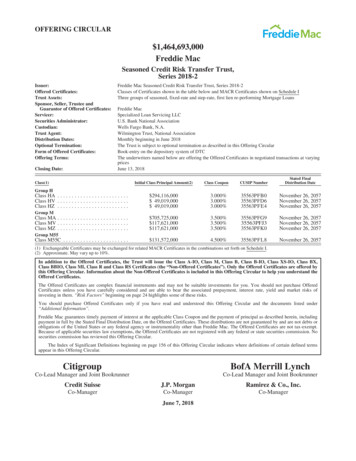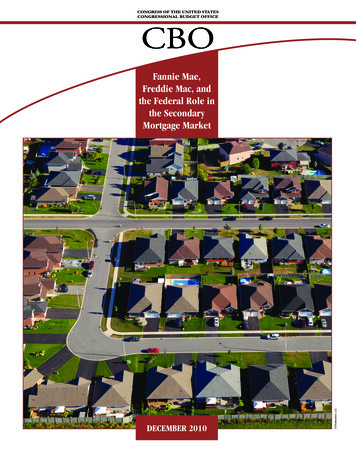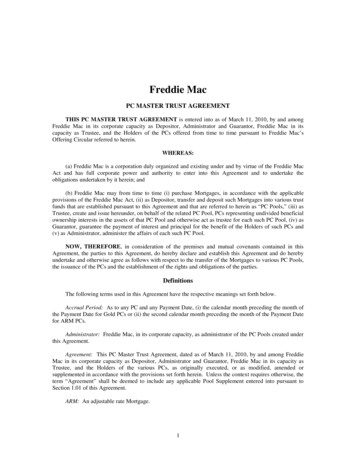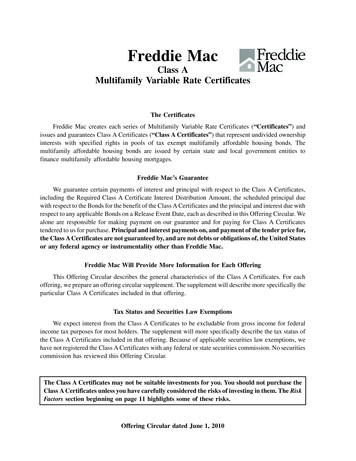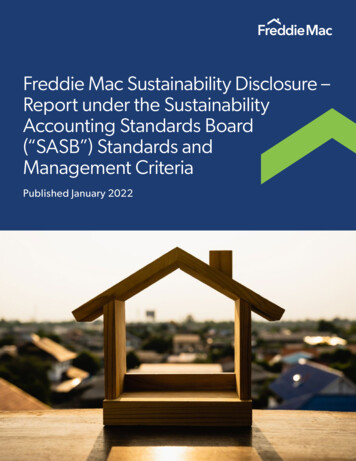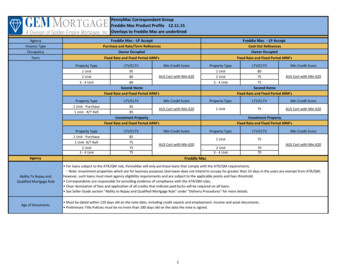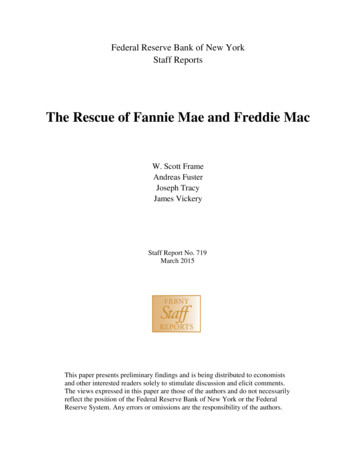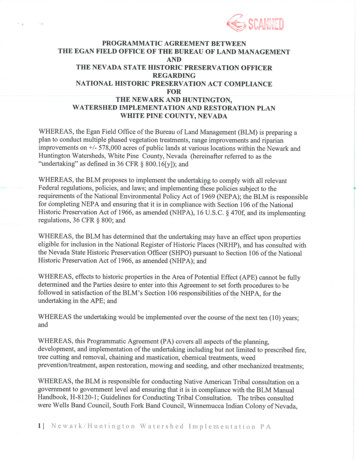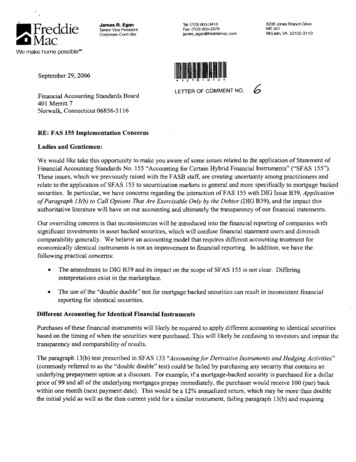
Transcription
Freddiei.JFreddie.oiMacft MacJames R.R. EganSenior Vice PresidentControllerCorporate Controller8200 Jones Branch DriveDriveMS 301301McLean, VAVA 22102-3110Tel: (703) 903-3410Fax: (703) 903-2978jarnes egan@freddiemac.comjames egan@freddiemac.comWe make home possiblepossible3wSeptember 29,29,2006September2006Financial Accounting Standards Board40I Merritt 7401Merritt706856-5116Norwalk, Connecticut 06856-51161 Z 1 O - H Y U *LETTER OF COMMENT NO.6RE: FAS 155155 Implementation ConcernsConcernsLadies and Gentlemen:We would like take this opportunity to make you aware of some issues related to the application ofofof StatementStatement of155 "Accounting"Accounting for Certain Hybrid Financial Instruments" ("SFAS ISS").155").Financial Accounting Standards No. ISSThese issues, which we previously raised with the FASB staff, are creating uncertainty among practitioners andrelate to the application ofAS ISSof SFSFAS155 to securitization markets in general and more specifically to mortgage backedsecurities.securities. In particular, we have concerns regarding the interaction ofFASof FAS ISS155 with DIG Issue B39, ApplicationApplicationofJ3(b) to Call Options That Are Exercisable Only by the DebtorDebtor (DIG B39), and the impact thisof Paragraph 13(b)authoritative literature will have on our accountingaccounting and ultimately the transparency of our financial statements.Our overriding concern is that inconsistencies will be introduced into the financial reporting ofof companies withsignificant investments in asset backed securities, which will confuse financial statement users and diminishcomparability generally. We believe an accountingaccounting model that requires differentdifferent accounting treatment foridentical instruments is not an improvement to financial reporting. In addition,addition, we have theeconomically identicalfollowing practical concerns:concerns: TheThe amendment to DIGDIG B39 andand itsits impactimpact onon thethe scope of SFAS 155155isis notnot clear. DifferingDifferinginterpretations exist in the marketplace. The useuse oftheof the "double double" test forfor mortgage backed securities cancan resultresult inin inconsistent financialThereporting for identical securities.securities.DifferentDifferent AccountingAccounting for Identical FinaucialFinancial InstrumentsPurchases oftheseof these financial instruments will likely be required to apply differentdifferent accounting to identical securitiessecuritiesbased on the timing ofof when the securities were purchased.purchased. This will likely be confusing to investors and impair thetransparency and comparability ofof results.The paragraph 13(b) test prescribedprescribed in SFAS 133133 "Accountingfor"Accounting for DerivativeDerivative Instruments and Hedging Activities"Activities"(commonly referred to as the "double"double double" test) could be failed by purchasing any security that contains anunderlying prepayment option at a discount.discount. For example, ifif a mortgage-backedmortgage-backed security is purchased for a dollar00 (par) backprice of 99 and all of the underlying mortgages prepay immediately, the purchaser would receive I100within one month (next payment date). This would be a 12%12% annualized return, which may be more than doublethe initial yield as well as the then current yield for a similar instrument, failing paragraph 13(b) and requiring
JIIJ Freddie MacMacWe make home possible possible3bifurcationbifurcation ofof the embedded prepayment option. Immediate prepayment of the same security purchased at parwould not result in an increase in yield.of 99 would have differentdifferent accounting from the exact sameAs a result, a security purchased one day at a price of99security purchased two days later at a price of 100. Applying SFAS ISS,155, as currently drafted, companies wouldwhile the security purchasedpurchased at 100mark to market the security purchased at 99 through the income statement whileavailable for sale security and marked to market through other comprehensivecomprehensive income.could be classified as an availableexample ofof differentdifferent accountingaccounting for similar securities is the discrepancydiscrepancy in accounting for individualindividualAnother examplemortgage loans underlying a mortgage-backed security versus the security itself.itself. A mortgage-backedmortgage-backed security,purchasedpurchased at a discount, would likely contain an embedded derivative not considered clearly and closely relatedwhereas a similar purchase of just the underlying collateral at a discount would not. This results from the fact thatof SFSFASmortgage loans are specifically scoped out ofAS 133.The only difference between the mortgage-backed securitysecurity and the mortgage loan is that the mortgage-backedlonger has credit risk based on the guarantee providedprovided in the security. The underlying prepaymentsecurity no longeroption is identical in every way, regardless of whether the loan is securitized or not. We believe an accountingmodel that does not require fair valuevalue accounting with changes in the income statement for a mortgage loan shouldvariability and risk is only lessened.not require such accounting for a virtually identical financial instrument whose variabilityDIG B39 interpretation confusionDIG B39 consideredconsidered the question of when the embedded derivative "double double" test should be applied toembedded options that allowed for the prepayment ofof a hybrid instrument. It concluded that the "double double"paragraph 13(b) ofof SFSFAS133 was not to be applied by investors who own instruments in which only thetest in paragraphAS 133amended by SFAS ISS),155), byissuer had the ability to exercise this option. Included in the scope of DIG B39 (as amendedSpecifically, mortgage backed securities in which the cashway of Example 6, were mortgage-backed securities. Specifically,prepayment option are proportionallyproportionally passed through to the investors are not subject to theflows related to the prepaymentparagraph 13(b) test. The prepayment option in mortgage backed securities in which these cash flows are notproportionally passed through are subject to the 13(b) test despite the fact that the investor cannot exercise anproportionallyoption to obtain the doubledouble return.This has created uncertainty among practitioners, specifically when considered in the contextcontext of how proportionalproportionalpass throughs ofAS 155of cash flows are defined in paragraph 1414 ofof SFSFAS155 for interest only and principal only securities.Proportional cash flows are defined in paragraph 14 as a straight pass through of underlying cash flows except forProportionalcompensation forfor stripping the instrument or to provide adequate compensationcompensation to a servicer". Excess"reasonable compensationdefinition ofof proportional.proportional.servicing, guarantees fees or any other fees would not meet the definitionIf it is appropriate to apply the paragraph 1414 definitiondefinition ofof proportional cash flows to the revised language ofof DIGB39, it is unclearunclear what mortgage backed securities this would be apply to. Those who interpret that the paragraph14 definition is not applicable to DIG B39 believe that agency single class pass throughs are eligible for this2
PI Freddie'I! Mac5O MacWe make hornehome possiblepossible*Wtreatmenttreatment while those who believe that the paragraph 1414 definition is relevant to DIG B39 believe that no mortgagemortgagebacked securities would be eligible for this treatment.It is our understanding, based upon discussionsAS 155discussions with staffstaff membersmembers duringduring the drafting ofof SFSFAS155 as well as ourreading of the related meeting minutes,minutes, that the amendment to DIG B39 contained in FAS 155155 was intended toclarifYclarify that the "double"double double" test should not be applied to agency single class mortgage backed securities.securities. Thisalso appears to be the impression of other constituents who had similar expectations regarding the intention ofof backedsecurities,issuedwithanyrevision. We know ofofregularity that could possibly be the target ofof this language. Securitizations where the resulting security is simply a100% proportional pass through of the underlyingunderlying security lack economiceconomic substance,substance, and, therefore, they do notexist on a meaningfulmeaningful scale.To illustrate this concern, consider a single class agency mortgage backed security. These instruments arebeneficialbeneficial interests in a pool of mortgage loans that are guaranteed by a Government Sponsored EnterpriseEnterprise("GSE") as requiredrequired by their federally mandated charters. The investor has purchased a securitysecurity that is a passthrough ofof the cash flows from the pool of mortgage loans except that the credit risk is removed through acompensated by a guarantee fee,fee, which is taken from the cash flows of theguarantee. The guarantee provider is compensatedmortgage pool. Additionally, a servicing fee to compensate the servicer is removed for handling the administrationof the loans. This fee will likely be considered "more than adequate" for accountingaccounting purposes. A typicaltypical couponcash flow is as follows:follows:Average rate on loans in the pool6.50%Servicing Fee (including adequateadequate plus excess) (.25%)GuaranteeGuarantee feeCoupon on security6.00%All of the cash flows of the mortgage loans are not proportionately passed through as paragraphparagraph 1414 ofFASof FAS 133133 (asamendedAS 155) requires. As previously stated, many in practice are interpretingamended by FFASinterpreting the guaranteeguarantee fee andexcess servicingservicing fee as disqualifYingdisqualifying a single class agency pass through mortgage backed security from theapplication ofof DIG B39 exemption from the "double double" test.We have concluded, based upon our knowledge of the deliberations around FAS 155, that the use ofof the words"cash"cash flows associatedassociated with the embedded call feature" does not apply to the stripping ofof the guarantee andservicing fees as those fees can be viewed as a cash flow not related to the embedded call feature. However,However, weunderstand that many practitionerspractitioners do not hold this same interpretation.interpretation.derivative ififWe believe that a guaranteed mortgage backed security should not be considered to have an embedded derivativeunderlying mortgagemortgage loan does not. This accountingaccounting model lacks representational faithfulnessfaithfulness because itthe underlying3
,M Freddie FreddieMac MacWe make home possible possible9provides differentdifferent accounting answers based on form for what is the economicallyeconomically identicalidentical transaction. This topic14, 20052005 Board Meeting, Issue 7, where the FFASBstaff recommendedrecommended that prepaymentwas raised in the December 14,ASB staffconsidered clearly and closely relatedrelated to the debt host as established in DIG B39.options in securitizations be considereddifferent interpretationsinterpretations could lead to differentdifferent accountingaccounting treatments amongst differentdifferentWe are concerned that differentindividual interpretations,interpretations, i.e. some may interpret single class pass throughs as out of scope ofcompanies based on individualofthe "double double" test, while others may interpret them as in scope. This would create financialstatementsthatfinancialare not comparable within industriesindustries and, significant confusionconfusion amongst analysts and investors.13 (b) "double double" test to mortgagemortgage backed securitiesApplication of Paragraph 13The "double double" test is only required of embeddedembedded derivative instrumentsinstruments where the underlying is an interestinterest rate index that alters net interest payments that would be paid or received. In a mortgage-backedrate or an interestsecurity that can be prepaid,prepaid, the underlyingofunderlying is not an interestinterest rate or an interest rate index. In fact, paragraph 7 of133 identifies underlyingsunderlyings".orSFAS 133" . or other variable (including the occurrence or nonoccurrence of specifiedevent such as the payment under a contract)." It further states that the settlement ofof a derivative is dependent onthe interaction of the underlying with the notional. We believe that the underlyingunderlying in the potentialpotential prepaymentrelated derivative embedded within a mortgage-backed security to be whether or not the underlying mortgagesmortgageactually prepay. PrepaymentPrepayment on a mortgagemortgage may be interest related, however if interest rates decline, mortgagemay not prepay. In fact, when consideringconsidering a poolpooi ofof mortgagemortgage loans, prepayments often result from noneconomicevents, such as death, divorce and relocation. Conversely,Conversely, many mortgages will prepay even when interest ratessubstance of the "double double" test is to capture instruments that contractually areincrease. We believe the substancerequired to pay the double return in an interest rate scenario, not those that would double if a certain contingencyif the likelihoodlikelihood of the contingency is primarily driven by interest rates.occurred, even iftheThe determinationembedded derivative requiring bifurcation exists requires estimatesestimates aboutdetermination as to whether an embeddedbehavior in extreme interest rate scenarios[mph11.scenarios[mphl]. Such predictionspredictions would be model driven, given theprepayment behaviorextreme nature ofof the interest rate scenarios and not based on empirical infonnation.information. In other words, the discountthat creates an embeddedembedded derivative requiring bifurcation would vary from practitioner to practitioner based uponwhose prepaymentprepayment model was used.used. It should be noted that while these models may be highly accurate atpredicting prepayment speeds over large samples, they are not designed to predictpredict accurately what would happen inenvironments required to be consideredconsidered under paragraph 1313 (b).the extreme interest environmentsConclusionsConclusionsThe application ofof paragraph 1313 (b) to prepayment options in mortgage backed securities is highly problematic andnot an improvement in financial reporting. That is not to say that we believe mortgage backed securitiessecurities dodo nothave embeddedembedded derivatives related to prepayment optionality.optionality. Application of the "double double" test forprepayment options seems to be the wrong standard.standard.prepaymentGiven the confusion over how to apply the revised DIG B39 and the points discussed above, we ask that youreconsiderreconsider DIG B39. We think that prepayment risk should be treated similarly to credit risk and not require4
PI Freddie Freddie MacWe make home possible possible*considerationAS 133consideration under the "double double" test. SFSFAS133 was intended to subject interest rate related items to the"double-double" test, and although prepayment risk is associatedassociated with interest rate risk, it is not directly linked.In addition, we ask you to reconsider Example 6 in DIG B39. This example includes MBS in the scope of the"double double" test primarily as a result ofof a trust not having an option to pass through cash flows.flows. This createsdifferent accounting for similar securities merely through the introductionintroduction of a trust. By clarifYingclarifying Example 6 todifferentstate that the prepaymentprepayment option is in the control ofof the underlying mortgage holders in an MBS security, regardlessof the existence ofof the trust, and are therefore exempt from the "double doubledouble test", the discrepancydiscrepancy in accountingofmodels would be eliminated.concluded that clarifications regarding prepayment risk or ExampleExample 6 of DIG B39 are not required, weIf it is concludedof DIG B39 (as amended by SFAS 155) would bebelieve that clarification of the current wording in Example 6 ofrequiredrequired to solve current interpretationalinterpretational issues and the differences in accounting treatment betweenbetween companieswith identical transactions.transactions.of the DIG 01Dl scope exception would allow the time necessary toSimilarly, we believe that a delay of the removal ofcontradiction in the application ofthisof this guidance.further vet the issues and resolve the contradictionThank you for your attention to the matters raised in this letter. If you have any questions regarding our letterplease call me at (703)(703) 903-3410 or Tim AnnstrongArmstrong at (571)(571) 382-3738.SincerelyJames R. EganPresidentSenior Vice PresidentCorporate ControllerControllerCorporate5
8200 Jones Branch Drive MS 301 McLean, VA 22102-3110 RE: FAS 155 Implementation Concerns . relate to the application of SFAS 155 to securitization markets in general and more specifically to mortgage backed securities. In particular, we have concerns regarding the interaction of FAS 155 with DIG Issue B39, Application . Our overriding .
